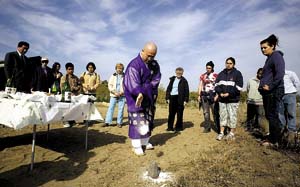After years of planning, semi-retired doctor Don Belt is ready
to begin construction of the Hollister Japanese Temple Garden. And
with the completion of a recent purification ceremony, the spirits
are ready, too.
After years of planning, semi-retired doctor Don Belt is ready to begin construction of the Hollister Japanese Temple Garden. And with the completion of a recent purification ceremony, the spirits are ready, too.
On Saturday, the garden’s supporters gathered to toss salt, sand, rice and sake onto the ground. Buddhist priest Taijo Imanaka, who presided over the ceremony, said each item has a specific, symbolic meaning. The salt purifies the ground, the sand represents “oneness,” the rice symbolizes energy and prosperity and the sake’s fumes will entertain the spirits in the ground.
“Maybe some people think, ‘What a primitive ritual this is,'” Imanaka said. “But it’s a very environment-conscious ritual. … This ritual, I believe, makes you realize the importance of help, of support, from the environment.”
Most of the locals, including Belt, were unfamiliar with the ceremony, but they gamely followed Imanaka’s lead.
“I didn’t know what to expect,” Belt said. “I’ve just seen pictures.”
The ceremony, he added, commemorates a major landmark in the planning process – namely, the issuing of a building permit for the garden’s reception center. Belt hopes to submit final plans for a bell tower and for the temple itself by the end of 2007, and to finish construction by five years from now.
Belt first presented his plans to San Benito County two years ago, and it hasn’t been an easy process. County Planner Lissette Knight said that when county staff first heard about the project, they were concerned because there were buildings on the site without permits. She said the process also has been complicated by Belt’s plan to move forward in phases.
“It did take longer, but it (should be) much easier now,” Knight said. “Something that could have been the worst turned around into something planned out and a new cultural avenue for San Benito County.”
Noting that she visited a Japanese temple garden while studying abroad, Knight said Belt’s vision could be “a really good thing” for the area.
She isn’t the only fan of the project, either. Hollister resident Elliott Treves said he has started attending events at the garden – including a recent drum circle – because he’s a student of Buddhism and he’s excited that things are moving forward.
“I’m very proud of the Belts and what they’re doing for the community,” Treves said. “I’m very honored to be here – it’s going to be amazing.”
Belt has said he’s not a Buddhist himself, but he wants to create a location that people can enjoy regardless of their religion. The temple, he said, will be part of the Shingon sect. But that’s because he hopes to eventually hire Imanaka – now living in Seattle – as the temple’s full-time priest.
“We’re looking mainly at the priest, not the sect,” Belt said.
In addition to celebrating the garden’s progress, Belt and Imanaka said the ceremony reminded everyone to be grateful to the environment for their success – and for life itself.
“If (there are) no animals and no plants, no human beings can exist,” Imanaka said. “This is not fantasy or poetry, just the facts.”










